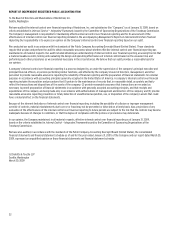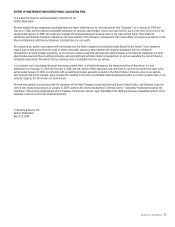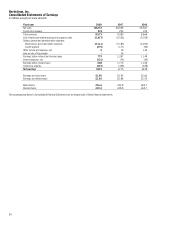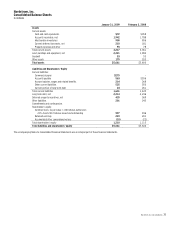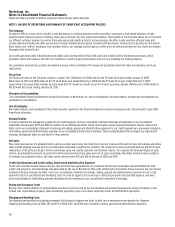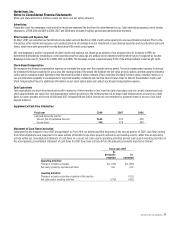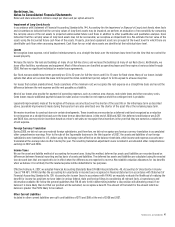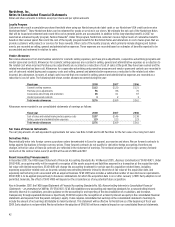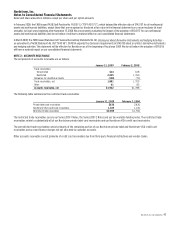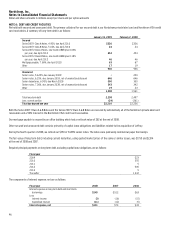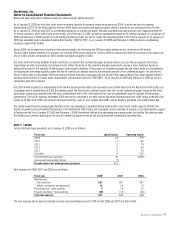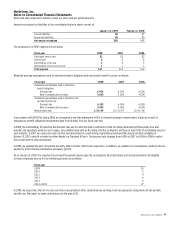Nordstrom 2008 Annual Report Download - page 41
Download and view the complete annual report
Please find page 41 of the 2008 Nordstrom annual report below. You can navigate through the pages in the report by either clicking on the pages listed below, or by using the keyword search tool below to find specific information within the annual report.
Nordstrom, Inc. and subsidiaries 41
Nordstrom, Inc.
Notes to Consolidated Financial Statements
Dollar and share amounts in millions except per share and per option amounts
Impairment of Long-Lived Assets
In accordance with Statement of Financial Accounting Standards No. 144
, Accounting for the Impairment or Disposal of Long-Lived Assets
, when facts
and circumstances indicate that the carrying values of long-lived assets may be impaired, we perform an evaluation of recoverability by comparing
the carrying values of the net assets to projected undiscounted future cash flows in addition to other quantitative and qualitative analyses. Upon
indication that the carrying values of long-lived assets may not be recoverable, we recognize an impairment loss. We estimate the fair value of the
assets using the discounted future cash flows of the assets. Property, plant and equipment assets are grouped at the lowest level for which there are
identifiable cash flows when assessing impairment. Cash flows for our retail store assets are identified at the individual store level.
Leases
We recognize lease expense, net of landlord reimbursements, on a straight-line basis over the minimum lease term from the time that we control the
leased property.
We lease the land or the land and buildings at many of our full-line stores, and we lease the buildings at many of our Rack stores. Additionally, we
lease office facilities, warehouses and equipment. Most of these leases are classified as operating leases and they expire at various dates through
2080. We have no significant individual or master lease agreements.
Our fixed, noncancelable lease terms generally are 20 to 30 years for full-line stores and 10 to 15 years for Rack stores. Many of our leases include
options that allow us to extend the lease term beyond the initial commitment period, subject to terms agreed to at lease inception.
For leases that contain predetermined, fixed escalations of the minimum rent, we recognize the rent expense on a straight-line basis and record the
difference between the rent expense and the rent payable as a liability.
Most of our leases also provide for payment of operating expenses, such as common area charges, real estate taxes and other executory costs.
Some leases require additional payments based on sales and are recorded in rent expense when the contingent rent is probable.
Leasehold improvements made at the inception of the lease are amortized over the shorter of the asset life or the initial lease term as described
above. Leasehold improvements made during the lease term are also amortized over the shorter of the asset life or the remaining lease term.
We receive incentives to construct stores in certain developments. These incentives are recorded as a deferred credit and recognized as a reduction
to rent expense on a straight-line basis over the lease term as described above. At the end of 2008 and 2007, this deferred credit balance was $478
and $408. Also, we may receive incentives based on a store’s net sales; we recognize these incentives in the year that they are earned as a reduction
of rent expense.
Foreign Currency Translation
During 2008, we did not own any material foreign subsidiaries, and therefore, we did not recognize any foreign currency translation in accumulated
other comprehensive earnings. Prior to the sale of the Façonnable business in the third quarter of 2007, the assets and liabilities of our foreign
subsidiaries were translated to U.S. dollars using the exchange rates effective on the balance sheet date, while income and expense accounts were
translated at the average rates in effect during the year. The resulting translation adjustments were recorded in accumulated other comprehensive
earnings in 2007 and 2006.
Income Taxes
We use the asset and liability method of accounting for income taxes. Using this method, deferred tax assets and liabilities are recorded based on
differences between financial reporting and tax basis of assets and liabilities. The deferred tax assets and liabilities are calculated using the enacted
tax rates and laws that are expected to be in effect when the differences are expected to reverse. We establish valuation allowances for tax benefits
when we believe it is not likely that the related expense will be deductible for tax purposes.
Effective February 4, 2007, we adopted Financial Accounting Standards Board (FASB) Interpretation No. 48,
Accounting for Uncertainty in Income
Taxes
(“FIN 48”). FIN 48 clarifies the accounting for uncertainty in income taxes recognized in financial statements in accordance with Statement of
Financial Accounting Standards No. 109
, Accounting for Income Taxes
. In accordance with FIN 48, we regularly evaluate the likelihood of realizing the
benefit for income tax positions we have taken in various federal, state and foreign filings by considering all relevant facts, circumstances and
information available. We follow the general guidelines that FIN 48 sets forth in determining whether a tax position will ultimately prevail. If we
believe it is more likely than not that our position will be sustained, we recognize a benefit. The amount of the benefit is the amount which we
believe is greater than 50% likely to be realized.
Other Current Liabilities
Included in other current liabilities were gift card liabilities of $175 and $188 at the end of 2008 and 2007.



